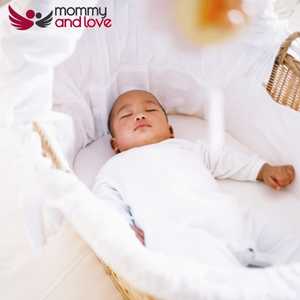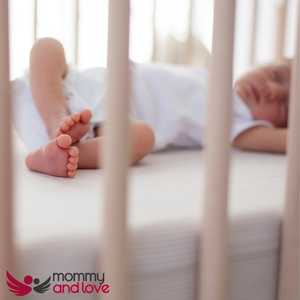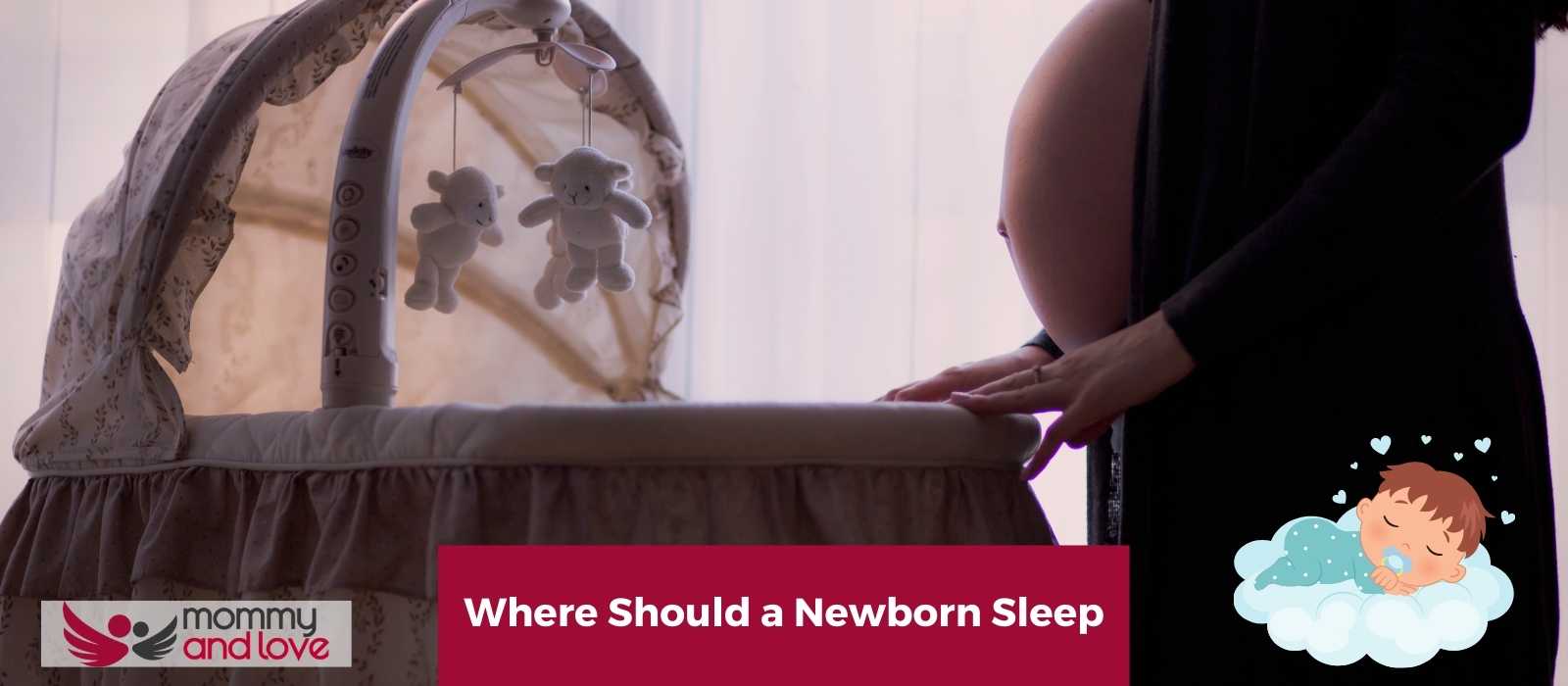Enough sleep is crucial for everyone, especially for babies. It’s important for them to get a good amount of sleep so that they can grow and develop properly. This is why it’s important for parents to choose a baby’s sleep area for their little ones.
Babies should sleep in their own sleep space which can either be a crib or a bassinet, in the same room as their parents for six to twelve months, according to the American Academy of Pediatrics.
What Is Considered a Safe Sleep Environment for Newborns?
It is essential to follow safe sleep guidelines and practices in order to protect your baby from Sudden Infant Death Syndrome (SIDS) and other accidents. Where a baby sleeps is important. Caregivers and parents should provide a safe environment for their children to sleep in to prevent any tragic sleep-related infant deaths.
Bassinets

A baby’s bassinet is a great option for your newborn’s sleeping space.
Unlike a crib, which is designed for an older baby or toddler, a bassinet is smaller and lower to the ground, making it easier for you to reach your baby in the middle of the night.
Bassinets also typically come with built-in features like storage baskets and white noise machines, which can be helpful for new parents.
Most importantly, however, a bassinet will give your baby a safe, comfortable place to sleep during those first few months of life. When your baby outgrows the bassinet, simply transition them to a crib – no need to buy new furniture.
Cribs
When your baby has outgrown her bassinet, she can start sleeping in a crib. And yes, babies can sleep in cribs from day one.
With so many different styles and brands on the market, it can be hard to know where to start. However, there are a few important factors to keep in mind when choosing a crib for your child.
- Make sure that the crib has not been recalled. You can check for recall information on the website of the Consumer Product Safety Commission. In addition, make sure that all of the hardware is present and in good condition.
- Do not use a crib with missing or broken parts, as this could pose a safety hazard.
- In order to keep your baby safe, it is important to make sure that the crib you are using is in good condition. Inspect the crib regularly for any signs of damage. And if you notice any damage to the crib, don’t attempt to fix it.
- You should not keep crib bumpers, loose bedding, toys, or other soft objects such as a stuffed animal in your baby’s crib.
- Use only the mattress that is made for your baby’s crib. Crib mattresses are different for each which means a mattress may fit in one crib but not in others.
- Avoid using a soft mattress and instead, use a firm mattress.
- Keep in mind that your child will spend a lot of time in their crib, so make sure to choose one that you feel comfortable with.
Portable Cribs and Playgrounds

Though they may look like simple playthings, playards are actually federally regulated for infant sleep.
That’s because they provide a safe, comfortable place for babies to sleep, just like bassinets and cribs.
In fact, many parents find that a play yard is just as convenient and practical as traditional cribs, but without the high price tag. Plus, a play yard can be portable, so they can be easily moved from room to room or even taken on vacation.
Additional Baby Sleep Safety Tips
- It’s important to always put your baby to sleep in a baby’s crib or bassinet. This will ensure that they are safe and comfortable. Plus, it’ll help them get a good night’s sleep.
- The crib mattress should be covered in a tightly fitted sheet.
- It’s generally recommended that you share a room with your baby, but not a bed. This allows you to more easily monitor your baby and respond to their needs during the night. Plus, it can help promote bonding and attachment between you and your little one.
- Parents shouldn’t allow their baby to sleep on their beds or other soft surfaces. Instead, they should always be in a safe and firm crib. Sleeping on their parent’s beds can be extremely dangerous for babies and can lead to sudden infant death syndrome. Always make sure your baby is sleeping in a safe and secure environment.
- A car seat, infant carrier, infant sling or stroller are never safe places for your baby to sleep as the baby’s head can fall forward. If your baby falls asleep in one of these devices, be sure to transfer them to a safe sleep surface as soon as possible.
- Don’t hang a pacifier to your baby’s neck or clothing. If the pacifier falls while your baby is sleeping, don’t put it back in your baby’s mouth.
- Make sure you can see your baby’s face when you look down at them in the sling. The soft fabric should not cover their head completely.
- Establish a consistent bedtime routine so that sleep training will be a breeze.
- For your baby’s safety, don’t bed-share especially if she’s younger than 4 months.
- Make sure that your baby’s head and face are not covered while falling asleep in their portable crib.
- Baby swings and bouncers may be tempting for naps, but it’s important not to let your little one sleep soundly in them.
- If you practice swaddling, make sure your swaddled baby is sleeping in a bassinet right next to your bed.
- There is no evidence that home cardiorespiratory monitors lower the risk of SIDS in healthy babies.
- Don’t let your baby sleep while in a sleep positioner. Sleep positioners and anti-roll pillows are not recommended because your baby could end up in an awkward position and might not be able to move which can cause suffocation.
- The baby’s sleep area should be a firm sleep surface.
- Dress your baby in appropriate clothing. Use a sleep sack instead of a light blanket while she sleeps in her own bassinet.
- To reduce the risk of SIDS, suffocation, entrapment, and strangulation, keep soft objects such as stuffed animals, plush toys, and loose blankets as well as bedding away from the sleep area of your baby. These objects can interfere with your baby’s breathing.
Conclusion on Where Can a Newborn Sleep
It is so important for parents to provide their baby with a safe sleep environment. By following safe sleep practices, you can help ensure that your baby can sleep safely and enjoy the best possible night’s sleep. And who knows? Maybe by getting a good night’s sleep, your baby will be in a better mood during the day – and that means less crying and more fun!
FAQs on Newborn Sleep
Does Bed-Sharing Increase the Risk of Sudden Infant Death Syndrome?
The rate of SIDS, or sudden infant death syndrome, has been on the decline in recent years. However, bed-sharing remains a major risk factor for SIDS, especially in younger newborn infants.
When an infant shares a bed with another person, there is an increased risk of suffocation or strangulation. In addition, bed-sharing can also increase the risk of overheating, as a sleeping baby can easily become trapped under blankets or pillows.
Can Babies Sleep in Bedside Sleepers?
The use of bedside sleepers and in-bed sleepers has become increasingly popular in recent years, as parents look for ways to keep their babies safe and comfortable during the night without sharing the same bed.
However, there is still no clear consensus on whether or not these products are safe. The American Academy of Pediatrics (AAP) has not yet made a formal recommendation for or against the use of bed-side sleepers or in-bed sleepers, due to the lack of studies examining the potential risks and benefits of these products.
Some experts worry that bed-side sleepers and in-bed sleepers may increase the risk of Sudden Infant Death Syndrome (SIDS) or other unintentional injuries, due to the possibility of suffocation.
However, until more research is conducted, it is difficult to say for sure whether or not these products are safe. In the meantime, parents should use their best judgment when deciding whether or not to use a bed-side sleeper or an in-bed sleeper with their child.
Before buying one, check CPSC’s requirements.
Can Babies Sleep on a Bed?
There is no need to worry if you occasionally share a bed with your newborn baby. Sometimes breastfeeding mothers fall asleep while feeding their babies. And in this case, it’s safe to sleep on the bed instead of sleeping on the sofa or armchair. So, although it is ideal for them to sleep in their own crib or bassinet, occasional bed-sharing will not cause any harm.
However, there are also some risks associated with bed-sharing, so it is important to be aware of these before you decide to do it. The most important thing is to make sure that both you and your baby are comfortable and safe.
How Important Is a Dark Room for Baby Sleep?
Around three months old, your baby’s body will start to produce the hormone melatonin, which helps regulate sleep. Melatonin is produced in the pineal gland, and its production is triggered by darkness. Therefore, when you put your baby in a dark room for naps or nighttime sleep, their brain will start to produce melatonin and they will become sleepy.
You can help encourage the production of melatonin by keeping the room dark and using white noise to create a calming environment. By helping your baby’s body produce melatonin on a regular basis, you can encourage healthy sleep habits that will last a lifetime.
Is Room Sharing With the Baby Necessary?
Yes, the AAP recommends room-sharing because it lowers the risk of sudden infant death syndrome (SIDS).
How Long Will My Newborn Sleep?
Most newborns should be getting enough sleep of 14 to 17 hours including daytime naps says the National Sleep Foundation. However, each baby has a different sleep pattern so some newborns may sleep up to 18–19 hours a day.
Do Breastfed Babies Have a Lower Risk of SIDS?
Breastfeeding or feeding your expressed milk for the first 6 months of your baby’s life reduces the risk of SIDS and is good for child health. In fact, the American Academy of Pediatrics recommends that all babies be fed breast milk in order to reduce the risk of SIDS. Not only does breastfeeding keep the baby healthy, but also keeps your baby safe from sleep-related deaths.

This article was written by: Gian MIller – Full-Time Writer, Baby Whisperer & Dad of 3.
Gian spends a lot of his time writing. A self-proclaimed baby whisperer, Gian has been through it all with his own children and is passionate about sharing his hard-won wisdom with other parents. When he’s not writing or changing diapers, you can find him playing the guitar or watching baseball (or preferably both at the same time).




